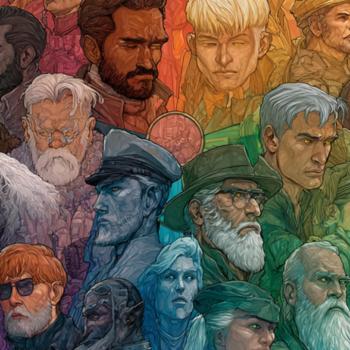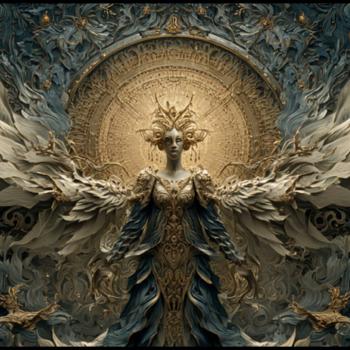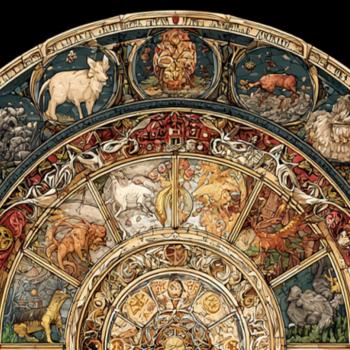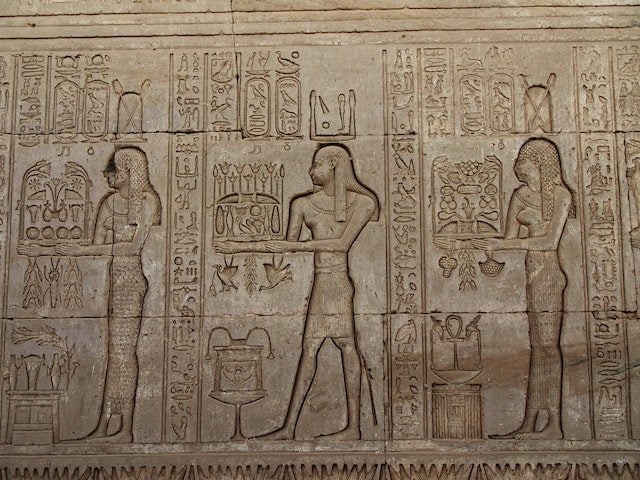
Let me start off by telling you a story first. See if you’ve heard something like it before. What if I told you there was a person who was born of a virgin whose name was Mary, had a step-father named Joseph, and was birthed in a cave where animals were kept, and his birth was announced by an angel, there was a great star in the sky overhead as a sign, and there were shepherds there. When he was 12 there was a special rite of passage he went through, but the ancient texts are silent about his life between the ages of 12 and 30 but when he was 30 he was baptized in a river by a guy who was later beheaded. This person had 12 disciples, he performed miracles, he cast out demons, walked on water and raised people from the dead. People started calling him “the son of God”, “the way, the truth, the light”, “Messiah”, “the Holy One” and he delivered a sermon on a mount and was transfigured on a mountain. Eventually he was crucified between two thieves, buried and three days later he rose from the dead. His followers later wrote down his sayings so others could follow him.
You’re probably thinking, “Well, duh Keith, yes I have heard that story before. It’s about Jesus of Nazareth from the Gospels” but there are some people out there who want you to believe that this story I just told you is actually the story of the Egyptian god, Horus. Maybe you’ve seen memes or posts online like this, or even videos on YouTube claiming that Horus and Jesus have the exact same story. The point these people are trying to make, of course, is that the Jesus story was completely fabricated and stolen from the myth of Horus, or Osiris, or Mithras or Krishna. Their goal is to convince you that nothing we read in the Gospels about Jesus actually happened but that it was all borrowed and recycled from other myths in the ancient world.
Here a few of the memes I’ve seen that make these sorts of claims about Jesus, Horus, Osiris and Mithras:
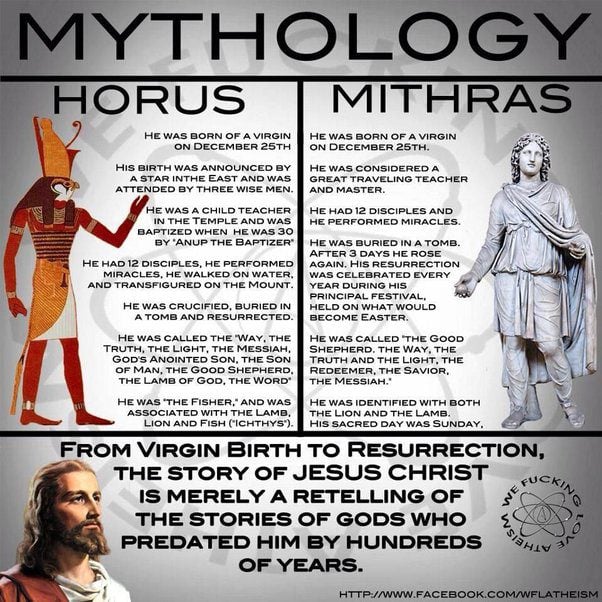
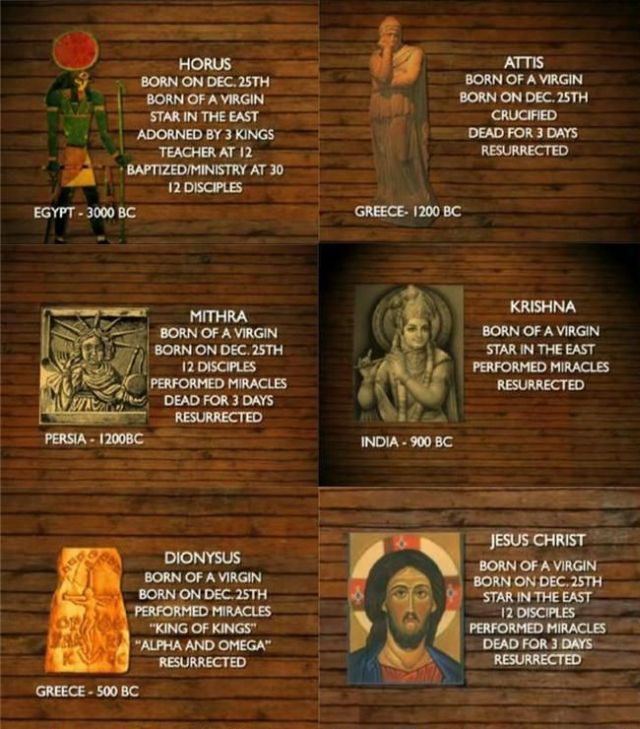
But, is this true? Are there any correlations between the life of Jesus and the myths of Horus, Mithras or Osiris? That’s what we want to examine in this chapter.
Let’s start with the story of Horus first and we’ll try to take one point at a time:
Was Horus born of a virgin whose name was “Mary”?
A simple Google search will show you that Horus was not conceived of a virgin. His mother was “Isis”, not “Meri” as some claim. Isis hovered over the erect penis of Osiris to conceive Horus. Does that sound like a virgin birth to you? If there is a penis and a vagina involved I’m not sure you can claim it’s a virgin birth.
Was Horus’s step-father named “Joseph”?
No. His step-father was named “Seb” which some claim is a form of “Joseph” but these are two different names. Seb was the earth god and was actually the father of Osiris – who was the actual father of Horus.
Was Horus later visited by three wise men?
No. There is no evidence of this anywhere.
Was the birth of Horus in a cave, surrounded by shepherds, announced by angels or accompanied by the sign of a star in the sky?
No on all four counts. Nothing anywhere in the story of Horus do we read anything about a cave, an angel, shepherds, or a star in the sky. Egyptologists confirm that Horus was born in a swamp, not a cave.
Was Horus later visited by three wise men?
Again, no. There’s no evidence of this in the story of Horus. Go look it up for yourself. It’s just not there.
Did Horus have a rite of passage at the age of twelve?
The correlation here to Jesus would be the scene where Mary and Joseph lose Jesus for three days and find him teaching the Jewish leaders in the Temple. But that doesn’t matter since there is no story about Horus having any rite of passage event when he was twelve.
Are we missing details about the life of Horus between twelve and thirty years of age?
No, because the story of Horus doesn’t give us any chronological details about his life growing at all.
Was Horus baptized at the age of thirty by a guy who was later beheaded?
By now you’re probably not surprised to read that this never happened to Horus. He was never baptized. Ever. So, there’s no reference to a baptizer being beheaded since Horus is never said to have been baptized at all, by anyone at any time. Sometimes you’ll read a claim that there was a guy named Anup the Baptizer who was later beheaded, but that person does not appear in any of the stories of Horus.
Did Horus have twelve disciples?
No. According to the story of Horus from Egyptian mythology, Horus had a total of four disciples. Later on there’s a reference to sixteen followers, but there is no reference to him having twelve disciples.
Did Horus perform miracles?
Well, Horus, as a god, did perform miracles but he never specifically is said to have ever cast out a demon, raised someone from the dead, or walking on water. There’s no correlation to the miracles of Jesus and Horus.
Was Horus called the “son of God”?
While technically Horus was the son of another god, he was never actually referred to as “the son of God.” In fact, no one was ever called that in any Egyptian mythology, ever. He was also never called the Lamb of God, the Way, the Messiah or anything like that.
Did Horus preach a sermon on a mountain or become transfigured?
Again, no. Horus never preached a sermon on a mountain. He was never transfigured on a mountain. His disciples did not write down his sayings after his death. Those claims are bogus.
Was Horus crucified between two thieves, buried and resurrected three days later?
Well, as you can probably guess, those things never happened to Horus. If you go examine Egyptian myths about Horus you’ll find that he was not only never crucified, he never died at all. He later merged with another god named “Ra” [the sun god], and so he does sort of die and become reborn at every sunset and sunrise, but that’s nothing at all like the death and resurrection of Jesus.
Now, there is a story where Horus is cut into pieces and thrown into the water, but later his mother Isis orders a crocodile to gather the pieces of his body and he was reassembled like Mr. Potato Head. But, again, that’s not a correlation to Jesus in any way.
Was Horus associated with fish, or lambs or lions?
In some versions of the Horus story Horus was actually a fish. But Jesus was never a fish, so there’s no correlation there. Horus was never called a lamb or a lion.
Was Horus prophesied to fulfill the law or reign for a thousand years?
There was no religious law for Horus to fulfill, and if there was we find no prophecy that Horus would fulfill any laws. There’s also no mention of his reigning for a thousand years.
Conclusion on Horus
So, the best way to debunk these sorts of claims is to simply read about these figures from ancient sources. Egyptologists are the only experts you need to consult when it comes to Horus or Osiris. They’ll tell you straight up that the similarities between those ancient Egyptian gods and Jesus are entirely fabricated by atheist apologists who want to rattle Christians with bogus claims about Horus being born of a virgin, or Osiris being crucified, etc. Don’t believe it. Simply go to your local library and check out a book about those ancient deities and read it for yourself. You’ll find nothing at all about those gods having 12 disciples or being baptized or crucified or raising from the dead three days later. It is merely propaganda intended to send Christians into an existential crisis. Don’t fall for it.
What’s really funny is that in my quest for details about the Horus/Jesus connection some of the best refutations I found were on the Richard Dawkins website – an atheist resource page – wherein they admitted that no such connections between the two exist, as much as they wish it did.
If you’re really interested in debunking this sort of thing, I highly recommend a two-part video lecture series on YouTube by Steve Gregg called Zeitgeist Refuted. In that lengthy series, Steve Gregg does the most excellent and thorough job possible of exposing this sort of nonsense one point at a time. It’s well-worth your time if you’ve got a few hours to kill and an interest in the truth about Jesus and those other ancient myths.
What about Mithras?
First we should probably provide a general overview of who Mithras was before we jump into the comparisons to Jesus.
According to Wikipedia:
Mithraism, also known as the Mithraic mysteries or the Cult of Mithras, was a Roman mystery religion centered on the god Mithras. Although inspired by Iranian worship of the Zoroastrian divinity (yazata) Mithra, the Roman Mithras is linked to a new and distinctive imagery, with the level of continuity between Persian and Greco-Roman practice debated. The mysteries were popular among the Imperial Roman army from about the 1st to the 4th century CE.
Some claim that Mithras was born of a virgin, on December 25th, in a cave with shepherds all around him. But the Bible never claims that Jesus was born in December, or in any particular month or date. The best that most Bible scholars can tell Jesus was most likely born in the summer – either June or July – not in December. That claim of December 25th came hundreds of years later. The story of Mithras is that he was born out of solid rock. So, maybe the rock could technically be a virgin, but that’s a bit ridiculous.
Another claim is that the birth of Mithras was attended by shepherds, but that notation only appears a hundred years after the Gospels were composed, so if anyone stole or copied something it was those who followed Mithras, not the followers of Jesus.
They say Mithras was a great teacher who travelled around preaching is message. But if you look at the mythology of Mithras it never claims he was a teacher of any kind so that doesn’t fit.
Did Mithras have twelve disciples? Again, there is nothing in the actual Mithras legends that name or number his disciples as being a group of twelve. Some attribute this idea to a single mural that was painted showing Mithras surrounded by twelve signs which look closer to the zodiac than anything else – one is the moon, the other is the sun, etc. – and those are not connected to disciples of Mithras at all. That painting also came long after the Gospels were written and so if there was any connection between Jesus and Mithras it was coming from the Mithras side and not the Jesus side.
Did Mithras promise his followers eternal life? No, not exactly. We can’t find any specific sayings or verses from Mithraic texts that suggest anything like this. But if he did that wouldn’t be unusual in comparison to all the other gods in the ancient world who often promised some type of blessing or benefit in the afterlife.
Does Mithras perform miracles? Yes, he does, but, as with the point above, so did every other religious figure in the ancient world. So, there’s no conspiracy or specific detail about a certain type of miracle that overlaps between Jesus and Mithras.
Did Mithras sacrifice himself in order to save the world or bring peace to everyone? The Mithraic narrative is that he killed a bull as an heroic deed. The bull died but Mithras didn’t. There’s no connection to the death of the bull and the salvation of humanity. It’s not there.
Was Mithras buried in a tomb only to rise again three days later? No because there’s no death story connected to Mithras. Since he doesn’t die there’s no burial and that means there’s no resurrection either. Tertullian does refer to the Mithraic cult of his day having some sort of resurrection celebration, but we have to keep in mind that this was over a hundred years after the time of Jesus and there are no other actual Mithraic references to such a thing. So, until we find more credible evidence the answer is, no, the followers of Mithra didn’t believe he died or was buried or that he rose from the dead.
Was Mithras called a shepherd, or was he ever compared to a lion or lamb? No, he wasn’t. There are no Mithraic texts that ever refer to Mithras in this way. Mithras is more like a sun god and so that’s why he has some association with the zodiac symbol Leo, but that’s not the same as calling him the Lion of God.
Was Mithras ever called the Logos, or the Word of God, or the Savior or the Messiah? Say it with me everyone: No. He wasn’t. Based on the Mithraic story none of those terms were ever applied to Mithras.
So, again, the pattern we find here is that claims made about the similarities between Mithras and Jesus come long after the Gospels were written. When we do see direct comparisons between them it’s the followers of Mithras who are borrowing from the Christ story, not the other way around.
Hopefully you get my point. You could do the same thing when it comes to comparisons between Osiris and Jesus, or between any other ancient deity and the life of Jesus. Just go online or grab a book on the actual historical religious deity and see for yourself whether or not the followers of Jesus borrowed stories from the ancient gods of their day.
The answer is no. That’s not what happened. So, please don’t fall for those memes that try to convince you that Jesus is a carbon copy of Mithras, or Horus or Osiris. It’s just simply false.
MEET ME IN NASHVILLE?

I’ll be one of the many amazing keynote speakers at AWAKEN: Nashville, June 9-10, 2023 at Spero Dei Church.
Our speakers include:
Dr. Jennifer Bird, Heather Hamilton, Karen Shock, EveWasFramed, Laci Bean, Desimber Rose, Dan Henderson, Nat Turney and David Moses Perez.
PLUS: Special Music Guest – Jennifer Knapp!
This is a safe place for anyone questioning their faith or those looking for hope, healing and community with others who are deconstructing their Christianity.
Early-Bird Rates Are Still Available! Only 125 Seats Remaining!
**
Keith Giles is the best-selling author of the Jesus Un series. He has appeared on CNN, USA Today, BuzzFeed, and John Fugelsang’s “Tell Me Everything.” His latest book, SOLA MYSTERIUM: Celebrating the Beautiful Uncertainty of Everything is available now on Amazon in paperback and on Kindle.




